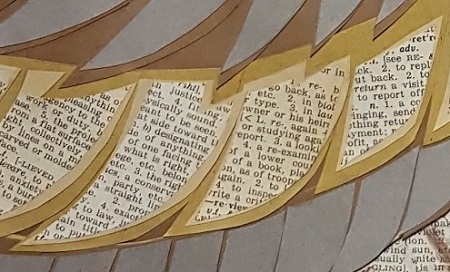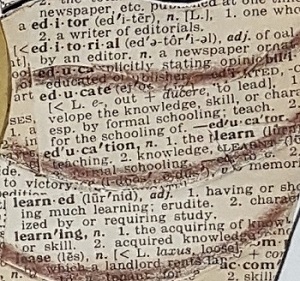
|
Cheryl Lemmens - Indexing and Editorial Services
Book Indexing • Web Site Indexing • Editing
Owl in a day's work ...
Bubo eruditus, the learned owl featured on the home page, comes by his wisdom naturally, with feathers crafted of card stock and pages from an old family dictionary.
 |

Details showing the use of dictionary text to craft Bubo eruditus. |
 |
Parsing the plumicorns: The wisdom of the great horned owl
The owl has long been a symbol of wisdom and knowledge, originally associated with the Greek goddess Athena and her Roman counterpart, Minerva — although this particular species was the "little owl," or Athena noctua. By contrast, the horned owl or eagle owl of Europe and Asia, Bubo bubo, was regarded with dread; Pliny the Elder (Natural History 10.16) tells of a purification ritual being performed in Rome after a horned owl "entered the very sanctuary of the Capitol."
In modern times, however, a reference to a "wise owl" is more likely to evoke the image of a horned owl, whether Bubo bubo or the great horned owl of the Americas, Bubo virginianus. Its "horns" or feather tufts (plumicorns) give it a formidable and distinguished appearance, serious and professorial. Horned owls have been depicted sitting on books or reading books, wearing academic mortarboards, and sometimes — despite those piercing eyes — wearing glasses. (Perhaps the most famous bespectacled owl is the "spokesbird" of the America's Best commercials, who informs unsuspecting consumers that "you paid too much for those glasses.")
Great horned owl sculptures can be found both inside and outside libraries around the world. At the Carnegie library of Accrington, Lancashire, Marjan Wouda's Owl of Few Words sculpture stands next to the staircase; Henry Gustave Hiller's stunning stained glass window includes an owl and the words "Knowledge is Power." In our own city, the Toronto Public Library's Beaches branch boasts a magnificent one-ton bronze sculpture of Wordsworth, a great horned owl with his wings spread protectively, at its entrance. And a stylized owl sculpture can be found on the north wall of the TPL's Lillian H. Smith branch, moved here from its former place at the Boys and Girls House on St. George Street. Really, there could be no other choice for any institution devoted to study and learning.